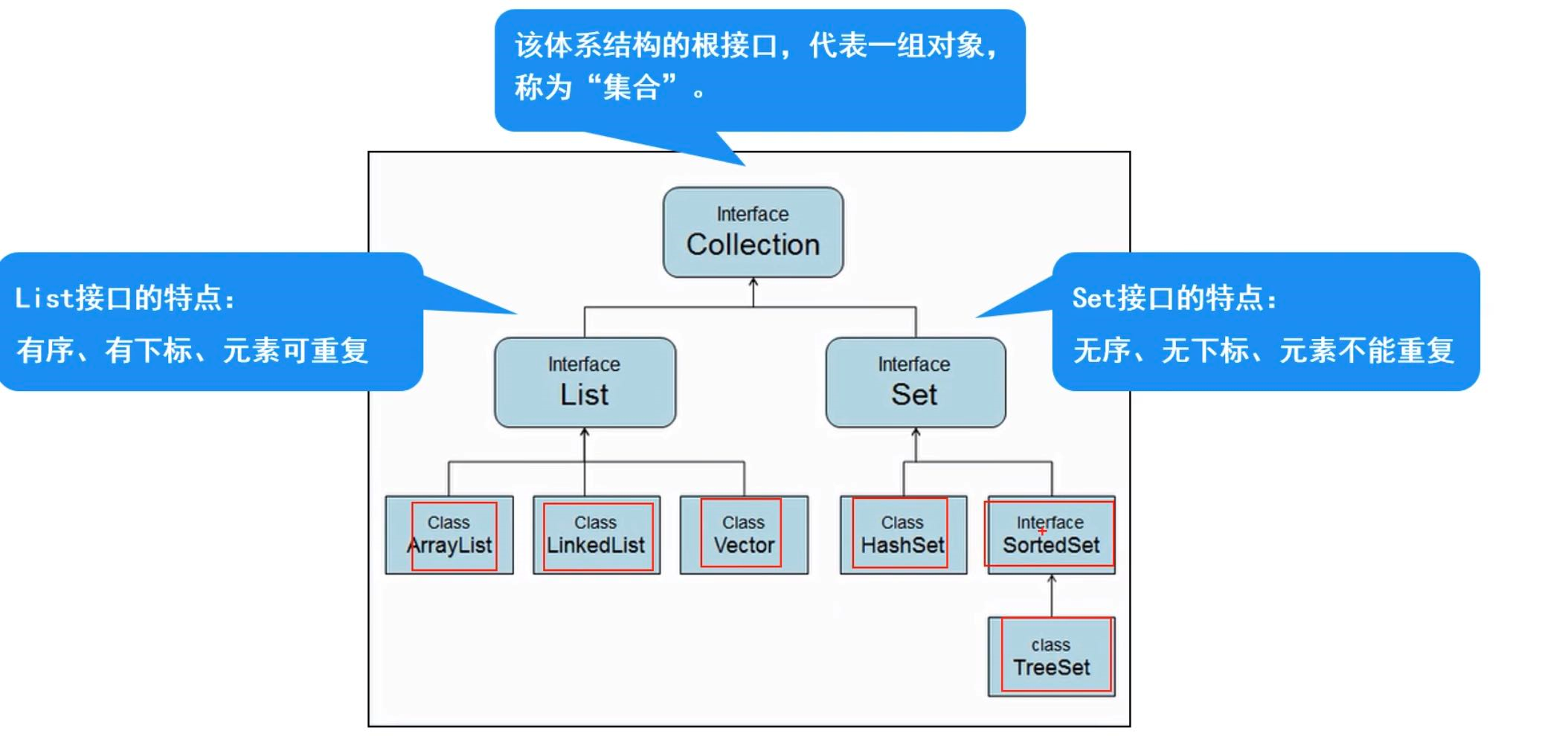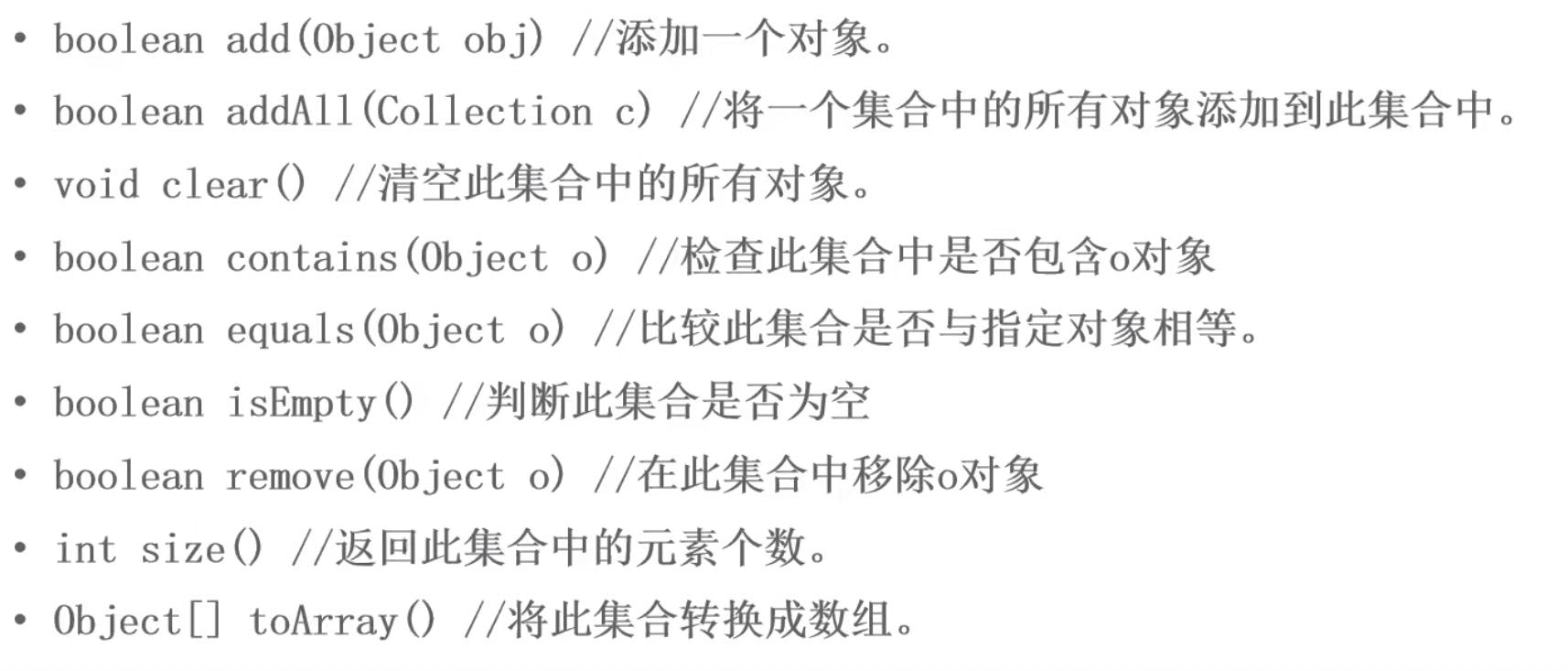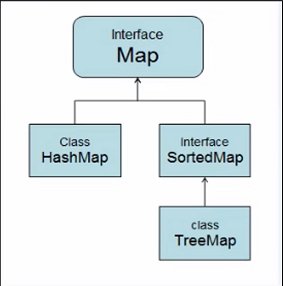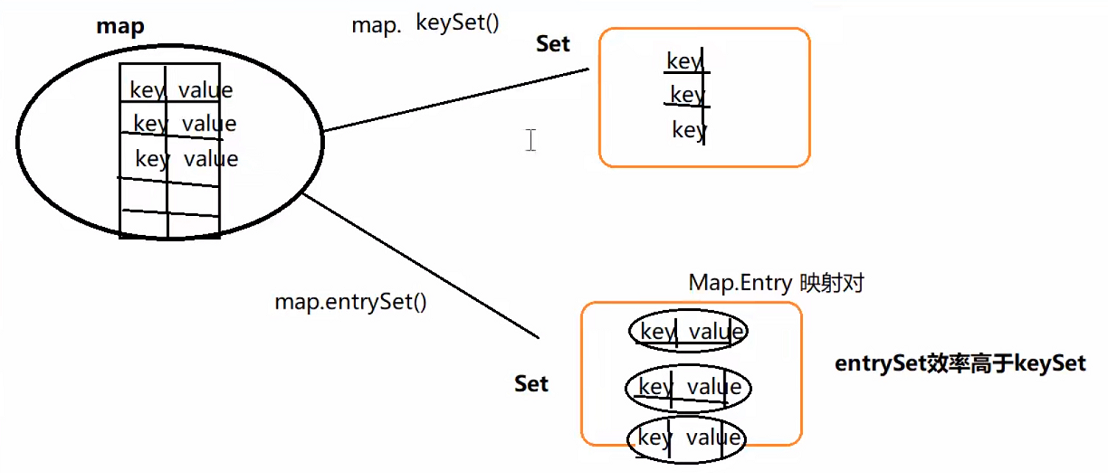集合框架 Collection和Map,泛型(Day12)

集合
- 概念:对象的容器,定义了对多个对象进行操作的常用方法。可实现数组的功能。
- 和数组的区别:1数组的长度固定 2集合的长度不固定
- 区别:3数组可以存储基本类型和引用类型 4集合只能存储引用类型
- 集合的位置 java.util.*
Collection体系集合

- List接口:有序的,有下标,元素可重复
- List接口的实现类有ArrayList(常用),LinkedList(常用),Vector(已经淘汰)
- Set接口:无序的,无下标,元素不可重复
方法:

代码实现(重点关注迭代器iterator的使用):
import java.util.ArrayList;
import java.util.Collection;
import java.util.Iterator;
public class Demo1 {
public static void main(String[] args) {
//创建集合
Collection collection = new ArrayList();
//1.添加元素
collection.add("香蕉");
collection.add("苹果");
collection.add("西瓜");
System.out.println("元素个数:"+collection.size());
System.out.println(collection);
//2.删除元素
//collection.remove("香蕉");
//collection.clear();//清除
//System.out.println("删除之后:"+collection.size());
//3.遍历元素(重点)
System.out.println("==========================");
//方法一:增强for
for (Object object:collection) {
System.out.println(object);
}
//方法二:使用迭代器(迭代器专门用来遍历集合的一种方式)
//iterator3个方法
//hasNext();有没有下一个元素
//next();l获取下一个元素
//remove();删除当前元素
System.out.println("==========================");
Iterator iterator = collection.iterator();
while (iterator.hasNext()) {
String s = (String) iterator.next();
System.out.println(s);
// collection.remove(s);//不允许使用collection删除会引发并发修改错误,只能使用以下方法移除
//iterator.remove();
}
System.out.println("元素个数:"+collection.size());
//4.判断
System.out.println(collection.contains("香蕉"));
System.out.println(collection.isEmpty());
}
}
List接口
- 特点:有序的,有下标,元素可重复
List接口实现类
-
ArrayList(重点)
数组的结构实现,查询快,增删慢
jdk1.2 ,运行效率快,线程不安全
-
Vector
数组的结构实现,查询快,增删慢
jdk1.0 ,运行效率慢,线程安全
-
LinkedList(重点)
链表的结构实现,查询快,增删慢
List接口代码使用
public class Demo3 {
public static void main(String[] args) {
//先创建一个集合对象
List list = new ArrayList();
//1.添加元素
list.add("唱");
list.add("跳");
list.add(0,"打篮球");//下标为0,放在第一位
System.out.println("元素个数:"+list.size());
System.out.println(list.toString());
//2.删除元素
// list.remove("唱");
// list.remove(1);
// System.out.println("元素个数:"+list.size());
// System.out.println(list.toString());
//3.遍历
//方法一:使用for遍历
System.out.println("===========for遍历===============");
for (int i = 0; i < list.size(); i++) {
System.out.println(list.get(i));
}
//方法二:使用增强for
System.out.println("===========增强for===============");
for (Object o:list) {
System.out.println(o);
}
//方法三:使用迭代器
System.out.println("===========迭代器===============");
Iterator iterator = list.iterator();
while (iterator.hasNext()) {
System.out.println(iterator.next());
}
//方法四:使用列表迭代器
//和迭代器的区别:可以向前或向后遍历,添加、删除、修改元素
System.out.println("===========列表迭代器===============");
ListIterator lit = list.listIterator();
System.out.println("===========列表迭代器从前往后===============");
while (lit.hasNext()) {
System.out.println(lit.nextIndex()+":"+lit.next());
}
System.out.println("===========列表迭代器从后往前===============");
while (lit.hasPrevious()) {
System.out.println(lit.previousIndex()+":"+lit.previous());
}
System.out.println("==========================");
//4.判断
System.out.println(list.contains("rap"));
System.out.println(list.isEmpty());
//5.获取位置
System.out.println(list.indexOf(2));
}
}
ArrayList
- 默认容量 DEFAVLT_CAPACITY = 10
- 存放元素的数组 elementDate
- size 实际元素个数add()方法 如果没有向集合添加任何元素时容量为0 添加任一元素之后容量变为10 数组扩容时为原来的1.5倍
ArrayList类的使用代码
/**
* ArrayList的使用
* 特点:有序,有下标,可以重复
* 存储结构:数组,查找遍历速度快,增删慢
*/
public class Demo5 {
public static void main(String[] args) {
//创建结合
ArrayList arrayList = new ArrayList();
//1.添加元素
Student s1 = new Student("张三",20);
Student s2 = new Student("李四",23);
Student s3 = new Student("王五",19);
arrayList.add(s1);
arrayList.add(s2);
arrayList.add(s3);
System.out.println("元素个数:"+arrayList.size());
System.out.println(arrayList.toString());
//2.删除元素
// arrayList.remove(0);
// arrayList.remove(s2);
arrayList.remove(new Student("ooof",12));//这样删除需要在Student中重写 equals(this == obj) 方法
//3.遍历元素【重点】
//使用迭代器
System.out.println("========= 使用迭代器=========");
Iterator it = arrayList.iterator();
while (it.hasNext()) {
Student s =(Student) it.next();
System.out.println(s.toString());
}
//列表迭代器
System.out.println("========= 列表迭代器=========");
ListIterator lit = arrayList.listIterator();
while (lit.hasNext()) {
Student s =(Student) lit.next();
System.out.println(s.toString());
}
System.out.println("========= 列表迭代器逆序=========");
while (lit.hasPrevious()) {
Student s =(Student) lit.previous();
System.out.println(s.toString());
}
//4.判断
System.out.println(arrayList.contains(new Student("王五",19)));
System.out.println(arrayList.isEmpty());
//5.查找
System.out.println(arrayList.indexOf(new Student("王五",19)));
}
}
Vector
- 存储结构:数组
- 使用很少
- 创建集合
Vector vector = new Vector<>(); - 增加(vector.add())、删除(vector.remove)、判断(vector.contains())同上
- 遍历–枚举器遍历
枚举器遍历集合
Enumeration en = vector.elements();
while(en.hasMoreElements()){
String s = (String)en.nextElement();
sout(s);
}
LinkedList
- int size :集合的大小
- Node first :链表头节点
- Node last :链表尾节点
LinkedList集合使用
/**
*LinkedList的使用
* 存储结构:双向链表
* 可以重复添加
*/
public class LinkedListTest1 {
public static void main(String[] args) {
//创建集合
LinkedList linkedList = new LinkedList<>();
//1.添加元素
Student s1 = new Student("张三",20);
Student s2 = new Student("李四",23);
Student s3 = new Student("王五",19);
linkedList.add(s1);
linkedList.add(s2);
linkedList.add(s3);
System.out.println("元素个数:"+linkedList.size());
System.out.println(linkedList.toString());
//2.删除
// linkedList.remove(s1);
// System.out.println("删除之后:"+linkedList.size());
//3.遍历
//for遍历
System.out.println("========for=====");
for (int i = 0; i < linkedList.size(); i++) {
System.out.println(linkedList.get(i));
}
System.out.println("========增强for=====");
for (Object object:linkedList) {
Student s = (Student) object;
System.out.println(s.toString());
}
//迭代器
System.out.println("========迭代器=====");
Iterator it = linkedList.iterator();
while (it.hasNext()) {
Student s =(Student) it.next();
System.out.println(s.toString());
}
System.out.println("========列表迭代器=====");
ListIterator lit = linkedList.listIterator();
while (lit.hasNext()) {
Student s =(Student) lit.next();
System.out.println(s.toString());
}
//4.判断
System.out.println(linkedList.contains(s1));
System.out.println(linkedList.isEmpty());
//5.获取
System.out.println(linkedList.indexOf(s1));
}
}
ArrayList与LinkedList的区别

- ArrayList:数组,必须开辟连续空间,查询快,增删慢
- LinkedList:双向链表,无需开辟连续空间,查询慢,增删快
泛型
- Java泛型是JDK1.5中引入的一个新特性,其本质是參数化类型,把类型作为参数传递
- 常见形式有泛型类、泛型接口、泛型方法
- 好处:
- (1)提高代码的重用性
- (2)防止类型转换异常,提高代码的安全性
泛型类
/**
* 泛型类
* 语法:<T>
* T表示类型占位符,表示一种引用类型,如果编写多个用逗号隔开
* */
public class MyGeneric<T> {
//使用泛型T
//1.创建变量,不能new T()因为T数据类型不确定
T t;
//2.创建一个方法,作为方法的参数
public void show(T t){
System.out.println(t);
}
//3.使用泛型作为方法的返回值
public T getT(){
return t;
}
}
泛型接口
/**
*泛型接口
* 语法:接口名<T>
* 注意:不能使用泛型来创建静态常量
*/
public interface MyInterface<T> {
String name = "张三";
T server(T t);
}
泛型方法
/**
*泛型方法
* 语法:<T>返回值类型
*/
public class MyGenericMethod {
//泛型方法
public <T> void show(T t){
System.out.println("泛型方法"+t);
}
}
泛型集合
- 概念:参数化类型、类型安全的集合,强制集合元素的类型必须一致。
- 特点:
- 编译时即可检查,而非逐行时抛出异常。
- 访问时,不必类型转换(拆箱)。
- 不同泛型之间引用不能相互赋值,泛型不存在多态。
代码演示
public class DemoCollect {
public static void main(String[] args) {
ArrayList<String> arrayList = new ArrayList<String>();
arrayList.add("xxx");
arrayList.add("yyy");
//指定String类型一下两条数据就不能添加进去
// arrayList.add(10);
// arrayList.add(20);
for (String str:arrayList) {
System.out.println(str);
}
ArrayList<Student> arrayList2 = new ArrayList<Student>();
Student s1 = new Student("张三",18);
Student s2 = new Student("李四",19);
Student s3 = new Student("王五",21);
arrayList2.add(s1);
arrayList2.add(s2);
arrayList2.add(s3);
Iterator<Student> iterator = arrayList2.iterator();
while (iterator.hasNext()) {
Student s = iterator.next();
System.out.println(s.toString());
}
}
}
Set接口
- 特点:无序的,无下标,元素不可重复
- 方法:全部继承Collection中的方法
Set代码使用
/**
* 测试Set接口的使用
* 特点:无序,无下标,元素不可重复
*/
public class Demo1 {
public static void main(String[] args) {
//创建集合
HashSet<String> set = new HashSet<>();
//1.添加数据
set.add("唱");
set.add("跳");
set.add("rap");
//set.add("rap");重复添加不进去
System.out.println("数据个数:"+set.size());
System.out.println(set.toString());
//2.删除
set.remove("唱");
System.out.println(set.toString());
//3.遍历【重点】
System.out.println("----增强for----");
for (String str:set) {
System.out.println(str);
}
System.out.println("----迭代器----");
Iterator<String> iterator = set.iterator();
while (iterator.hasNext()) {
String s = iterator.next();
System.out.println(s);
}
//4.判断
System.out.println(set.contains("打篮球"));
System.out.println(set.isEmpty());
}
}
Set接口实现类
- HashSet【重点】:
1.基于HashCode实现元素不重复,通过HashCode计算元素存放位置
2.当存入元素的哈希码相同时,会调用equalsi进行确认,如结果为true,则拒绝后者存入。 - TreeSet:
1.基于排列顺序实现元素不重复。
2.实现了SortedSet接口,对集合元素自动排序
3.元素对象的类型必须实现Comparable接口,指定排序规则
4.通过CompareTo方法确定是否为重复元素
HashSet
代码演示
/***
* HashSet集合的使用
* 存储结构:哈希表(数组+链表+红黑树)
* 存储过程:
* (1)根据hashcode计算保存位置,如果位置为空,则直接保存,如果不为空,执行第二步
* (2)再执行equals方法,如果equals方法为true,则认为是重复,否则形成链表
*/
public class Demo3 {
public static void main(String[] args) {
//新建集合
HashSet<Person> persons = new HashSet<>();
//1.添加元素
Person p1 = new Person("乔纳森-乔斯达",20);
Person p2 = new Person("乔瑟夫-乔斯达",19);
Person p3 = new Person("空条承太郎",16);
persons.add(p1);
persons.add(p2);
persons.add(p3);
persons.add(new Person("空条承太郎",16));//重写hashCode()形成链表,再重写equals()就不能添加进来了
System.out.println("元素个数:"+persons.size());
System.out.println(persons.toString());
//2.删除
// persons.remove(p1);
// persons.remove( new Person("乔纳森-乔斯达",20));//这时可以删除
// System.out.println("删除之后:"+persons.toString());
//3.遍历
System.out.println("------for----");
for (Person person:persons) {
System.out.println(person.toString());
}
System.out.println("------迭代器----");
Iterator<Person> iterator = persons.iterator();
while (iterator.hasNext()) {
System.out.println(iterator.next());
}
//4.判断
System.out.println(persons.contains(p1));
System.out.println(persons.isEmpty());
}
}
person类
public class Person {
private String name;
private int age;
@Override
public String toString() {
return "Person{" +
"name='" + name + '\'' +
", age=" + age +
'}';
}
public String getName() {
return name;
}
public void setName(String name) {
this.name = name;
}
public int getAge() {
return age;
}
public void setAge(int age) {
this.age = age;
}
public Person() {
}
public Person(String name, int age) {
this.name = name;
this.age = age;
}
@Override
public int hashCode() {
int n1 = this.name.hashCode();
int n2 = this.age;
return n1+n2;
}
@Override
public boolean equals(Object o) {
if (this == o) return true;
if (o == null || getClass() != o.getClass()) return false;
if(o instanceof Person){
Person person = (Person) o;
if(this.name.equals(person.getName())&&this.age == person.getAge()){
return true;
}
}
return false;
}
}
TreeSet
代码演示
/**
* 使用TreeSet保存数据
* 存储结构:红黑树
* 要求:元素必须要实现Comparable接口,compareTo方法返回值为0,认为是重复元素
*/
public class Demo5 {
public static void main(String[] args) {
//创建集合
TreeSet<Person> persons = new TreeSet<>();
//1.添加元素
Person p1 = new Person("7乔纳森-乔斯达",20);
Person p2 = new Person("5乔瑟夫-乔斯达",19);
Person p3 = new Person("3东方仗助",16);
Person p4 = new Person("3东方仗助",17);
//直接添加不能添加进去,因为没有比较规则,即没有实现Comparable接口,需要在Person类中实现
persons.add(p1);
persons.add(p2);
persons.add(p3);
persons.add(p4);
System.out.println("元素个数:"+persons.size());
System.out.println(persons.toString());
//2.删除
persons.remove(p4);
System.out.println("元素个数:"+persons.size());
//3.遍历
Iterator<Person> iterator = persons.iterator();
while (iterator.hasNext()) {
System.out.println(iterator.next());
}
//4.判断
System.out.println(persons.contains(p1));
}
}
person类必须实现Comparable接口
public class Person implements Comparable<Person>{
private String name;
private int age;
@Override
public String toString() {
return "Person{" +
"name='" + name + '\'' +
", age=" + age +
'}';
}
public String getName() {
return name;
}
public void setName(String name) {
this.name = name;
}
public int getAge() {
return age;
}
public void setAge(int age) {
this.age = age;
}
public Person() {
}
public Person(String name, int age) {
this.name = name;
this.age = age;
}
@Override
public int hashCode() {
int n1 = this.name.hashCode();
int n2 = this.age;
return n1+n2;
}
@Override
public boolean equals(Object o) {
if (this == o) return true;
if (o == null || getClass() != o.getClass()) return false;
if(o instanceof Person){
Person person = (Person) o;
if(this.name.equals(person.getName())&&this.age == person.getAge()){
return true;
}
}
return false;
}
//先按姓名比再按年龄比
@Override
public int compareTo(Person o) {
int n1 = this.getName().compareTo(o.getName());
int n2 = this.age - o.getAge();
return n1==0?n2:n1;
}
}
Comparator接口实现定制比较(不需要元素实现Comparable接口)
/**
* 使用TreeSet保存数据
* 存储结构:红黑树
* Comparator:实现定制比较(比较器)
*/
public class Demo6 {
public static void main(String[] args) {
//创建集合,并指定比较规则(匿名内部类)
TreeSet<Person> persons = new TreeSet<>(new Comparator<Person>() {
@Override
//先比较年龄再比较姓名
public int compare(Person o1, Person o2) {
int n1 = o1.getAge() - o2.getAge();
int n2 = o1.getName().compareTo(o2.getName());
return n1==0?n2:n1;
}
});
//1.添加元素
Person p1 = new Person("7乔纳森-乔斯达",20);
Person p2 = new Person("5乔瑟夫-乔斯达",19);
Person p3 = new Person("3东方仗助",16);
Person p4 = new Person("4东方仗助",16);
persons.add(p1);
persons.add(p2);
persons.add(p3);
persons.add(p4);
System.out.println(persons.toString());
}
}
TreeSet案例
/**
* 要求:使用TreeSet集合实现字符串按照长度进行排序
* Comparator实现定制比较
*
*/
public class Demo7 {
public static void main(String[] args) {
//创建集合并指定比较规则
TreeSet<String> treeSet = new TreeSet<>(new Comparator<String>() {
@Override
public int compare(String o1, String o2) {
int n1 = o1.length() - o2.length();
int n2 = o1.compareTo(o2);
return n1==0?n2:n1;
}
});
//添加数据
treeSet.add("hello");
treeSet.add("hello,world");
treeSet.add("dalian");
treeSet.add("kunkun");
treeSet.add("ikun");
treeSet.add("cat");
treeSet.add("beijing");
System.out.println(treeSet.toString());
}
}
Map集合框架

Map接口的特点:
- 用于存储任意键值对(Key-Value)
- 键:无序、无下标、不允许重复(唯一)
- 值:无序、无下标、允许重复
Map接口的使用
/**
* Map接口的使用
* 特点:(1)存储键值对(2)键不能重复,值可以重复(3)无序
*/
public class Demo1 {
public static void main(String[] args) {
//创建Map集合
Map<String, String> map = new HashMap<>();
//1.添加元素
map.put("tom","汤姆");
map.put("jack","杰克");
map.put("rose","露丝");
//map.put("rose","ooo");value会被替换
System.out.println("元素个数:"+map.size());
System.out.println(map.toString());
//2.删除
// map.remove("tom");
// System.out.println("删除后元素个数:"+map.size());
//3.遍历
//3.1使用keySet()
System.out.println("-------keySet()遍历---------");
//Set<String> keySet = map.keySet();
for(String key:map.keySet()){
System.out.println(key+"---"+map.get(key));
}
//3.2使用entrySet()
System.out.println("-------entrySet()遍历---------");
//Set<Map.Entry<String, String>> entries = map.entrySet();
for (Map.Entry<String, String> entry: map.entrySet()) {
System.out.println(entry.getKey()+"---"+entry.getValue());
}
//4.判断
System.out.println(map.containsKey("jack"));
System.out.println(map.containsValue("杰克"));
}
}
keySet()与entrySet()比较

Map接口的实现类
-
HashMap【重点】
1.jdk1.2版本,线程不安全,运行效率快
2.允许使用null作为key或value
3.初始容量为16,加载因子为0.75
-
TreeMap【重点】
1.实现了SortedMap接口(是Map的子接口),可以对key自动排序
-
Hashtable
1.jdk1.0版本 ,线程安全,运行效率慢,不允许null作为key或者value
2.子类Properties,要求key和value都是String,通常用于配置文件的读取
HashMap
HashMap的使用
/**
* HashMap集合的使用
* 存储结构:哈希表(数组+链表+红黑树)
* 存储过程:
* (1)根据hashcode计算保存位置,如果位置为空,则直接保存,如果不为空,执行第二步
* (2)再执行equals方法,如果equals方法为true,则认为是重复,否则形成链表
*/
public class Demo2 {
public static void main(String[] args) {
//创建集合
HashMap<Student,String> students = new HashMap<>();
//1.添加元素
Student s1 = new Student("张三",503);
Student s2 = new Student("李四",509);
Student s3 = new Student("王五",505);
students.put(s1,"3班");
students.put(s2,"7班");
students.put(s3,"8班");
//students.put(s3,"9班");键重复不能添加进去,但是值会覆盖
students.put(new Student("张三",503),"3班");
//会添加进去,new会在堆中新创建一个对象,如果要让它添加不进去,要在Student中重写hashcode和equals方法
System.out.println("元素个数:"+students.size());
System.out.println(students.toString());
//2.删除
// students.remove(s1);
// System.out.println("删除之后:"+students.size());
//3.遍历
//keySet()
System.out.println("-------keySet()遍历---------");
for (Student key: students.keySet()) {
System.out.println(key.toString()+"========="+students.get(key));
}
System.out.println("-------entrySet()遍历---------");
for (Map.Entry<Student,String> entry: students.entrySet()) {
System.out.println(entry.getKey()+"========="+entry.getValue());
}
//4.判断
System.out.println(students.containsKey(s1));
}
}
Student类:
public class Student {
private String name;
private int stuNo;
public Student(String name, int stuNo) {
this.name = name;
this.stuNo = stuNo;
}
public Student() {
}
public String getName() {
return name;
}
public void setName(String name) {
this.name = name;
}
public int getStuNo() {
return stuNo;
}
public void setStuNo(int stuNo) {
this.stuNo = stuNo;
}
@Override
public String toString() {
return "Student{" +
"name='" + name + '\'' +
", stuNo=" + stuNo +
'}';
}
@Override
public boolean equals(Object o) {
if (this == o) return true;
if (o == null || getClass() != o.getClass()) return false;
Student student = (Student) o;
return stuNo == student.stuNo && Objects.equals(name, student.name);
}
@Override
public int hashCode() {
return Objects.hash(name, stuNo);
}
}
HashMap源码分析
static final int DEFAULT_INITIAL_CAPACITY = 1 << 4; // aka 16 HashMap初始容量大小
static final int MAXIMUM_CAPACITY = 1 << 30; // HashMap数组的最大容量
static final float DEFAULT_LOAD_FACTOR = 0.75f; //默认加载因子为0.75(到75%时扩容)
static final int TREEIFY_THRESHOLD = 8; //链表长度大于8时,调整成红黑树
static final int UNTREEIFY_THRESHOLD = 6; //链表长度小于6时,调整成链表
static final int MIN_TREEIFY_CAPACITY = 64; //链表长度大于8,并且集合元素个数大于等于64时,调整成红黑树
transient Node<K,V>[] table; //哈希表中的数组
transient int size; //元素个数
HashMap源码
- HashMap刚创建时,table是null,为了节省空间,当添加第一个元素时,table容量调整为16
- 当元素个数大于阈值(16*0.75=12)时,会进行扩容,扩容后大小为原来的2倍,目的是减少调整元素的个数
- jdk1.8,当每个链表长度大于8,并且数组元素个数大于等于64时,会调整为红黑树,日的提高执行效率
- jdk1.8当链表长度小于6时,调整成链表
- jdk1.8以前,链表是头插入,jdk1.8以后是尾插入
TreeMap
- 实现了SortedMap接口(SortedMap是map的子接口),可以对key自动排序!
- 存储结构:红黑树
TreeMap代码演示
package com.Map.TreeMapclass;
import com.Map.HashMapClass.Student;
import java.util.Comparator;
import java.util.Map;
import java.util.Set;
import java.util.TreeMap;
/***
*
* TreeMap使用
* 存储结构:红黑树
* @author lxt
*/
public class TreemapDemo01 {
public static void main(String[] args) {
//创建TreeMap集合
TreeMap<Student,String> treeMap = new TreeMap<>(new Comparator<Student>() {
@Override //需要使用比较器,因为学生类不能直接转成Comparable。因为Treemap的存储结构是红黑树,需要制定一个规则进行比较!
// 所以需要使用Comparator比较器,才可正常遍历
public int compare(Student o1, Student o2) {
int n = o1.getId()-o2.getId(); //使用学号进行比较
return n;
}
});
//1、添加元素
Student s1 = new Student("张飞",101);
Student s2 = new Student("关羽",102);
Student s3 = new Student("曹操",103);
Student s4 = new Student("小猴子",100);
treeMap.put(s1,"广西");
treeMap.put(s2,"玉林");
treeMap.put(s3,"河池");
treeMap.put(s4,"广东");
System.out.println("元素个数:"+treeMap.size());
System.out.println(treeMap.toString());
//2、遍历元素
//2.1使用KeySet来遍历元素
System.out.println("-------------2.1使用KeySet来遍历元素---------------");
for (Student sss: treeMap.keySet()
) {
System.out.println(sss+treeMap.get(sss));
}
//2.2使用EnkeySet来遍历元素
System.out.println("-------------2.2使用EnkeySet来遍历元素---------------");
for (Map.Entry<Student,String> entry:treeMap.entrySet()
) {
System.out.println(entry);
}
//3、删除元素
treeMap.remove(s1);
System.out.println("删除后元素个数:"+treeMap.size());
}
}
总结:需要注意的就是,在使用Treemap集合的时候,由于Treemap的存储结构是红黑树,所以在使用Student类作为key遍历的时候,不能直接进行遍历,因为需要一个比较结果,所以必须要调用到比较器,也就是Comparator,否则会提示异常
Collections工具类
- 概念:集合工具类,定义了除存取以外的集合常用方法
- 方法:

演示代码
/**
* Collections工具类的使用
*
*/
public class Demo4 {
public static void main(String[] args) {
List<Integer> list = new ArrayList<>();
list.add(20);
list.add(77);
list.add(23);
list.add(89);
list.add(12);
//sort排序
System.out.println("排序前:"+list.toString());
Collections.sort(list);//升默认序
System.out.println("排序后:"+list.toString());
//binarySearch二分查找, 找到为下标,没找到为负数
int i = Collections.binarySearch(list, 12);
System.out.println(i);
//copy复制
List<Integer> dest = new ArrayList<>();
for (int j = 0; j < list.size(); j++) {
dest.add(0);
}
Collections.copy(dest,list);
System.out.println(dest.toString());
//reverse反转
Collections.reverse(list);
System.out.println("反转之后:"+list);
//shuffle 打乱
Collections.shuffle(list);
System.out.println("打乱之后:"+list);
//补充:list 转成数组
System.out.println("=======list 转成数组========");
Integer[] integers = list.toArray(new Integer[0]);
System.out.println(integers.length);
System.out.println(Arrays.toString(integers));
//数组转成集合
System.out.println("=======数组转成集合========");
String[] names = {"小明","小红","小王"};
//集合是一个受限集合,不能添加和删除
List<String> list1 = Arrays.asList(names);
System.out.println(list1);
//把基本类型数组转成集合时,需要修改为包装类
Integer[] nums = {100,200,300,400,500};
List<Integer> integerList = Arrays.asList(nums);
System.out.println(integerList);
}
}






















 1763
1763











 被折叠的 条评论
为什么被折叠?
被折叠的 条评论
为什么被折叠?








